Pkg Solutions
Quality Glossary
Paper and Board Making
DEFINITION
The Board and Paper Industry, for convenience, consider
that board is composed of substances whose combined weight exceeds 200
g/m2. Anything with a lower weight is termed paper.
Board and paper can be described as: "An interlaced
web of fibers formed by the action of felting from a water suspension
which is dried and finished, The fibers are normally of a vegetable origin,
but they may also be from other sources, as in the case of animal or synthetic
fibers".
FIBER TYPES
The most common fibers from which board is manufactured
are from wood sources and are composed of cellulose which forms the structural
body of the fiber, and lignum which binds the fibers together giving wood
its rigidity. It is the cellulose in fibers that is the main raw material
required for board making. Fiber size varies depending on the parent plant,
and from which part of the plant they are derived. On the basis of their
location in the plant, board making fibers can be divided into five categories:
|
Category |
Fiber Dimensions |
Cellulose
Content
|
| Length mm |
Width mm |
Seed Hairs
Cotton |
10 - 60 |
0.020 |
92% |
Bast Fibers
Flax
Hemp
Jute |
5 - 60
5 - 55
1.5 - 5.0 |
0.012 - 0.027
0.025 - 0.050
0.020 |
80%
77%
60% |
Leaf Fibers
Esparto
Manila |
0.05 - 2.0
2.50 - 12 |
0.013
0.025 - 0.040 |
55%
53% |
Wood Fibers
Deciduous (Hardwood)
Coniferous (Softwood) |
1.0 - 1.18
3.5 - 5.0 |
0.030
0.030 |
62%
58% |
Grasses
Cereal Straws
Bamboo |
1.0 - 3.4
1.5 - 4.0 |
0.023
0.030 |
Varies
60% |
Some of the uses of these fibers are:
- The pages of a library book are made from approximately 60% spruce (coniferous)
and 40% poplar (deciduous).
- Newspapers are made from a high percentage of softwood (spruce).
- Cigarette papers are made from 100% flax.
- Bank note paper is made from a mixture of cotton and linen fibers.
MANUFACTURING PROCESSES
The processes of converting wood into board can be considered
in three distinct phases:
Fiber Processes
1) Wood preparation - Reducing logs to chips used in
chemical and mechanical pulping.
2) Pulping and digestion - Removing lignum from the
chips, thereby releasing individual fibers.
3) Stock preparation (beating and refining) Mechanically
treating fibers in water to increase surface area flexibility and promote
bonding when dried.
Web forming
4) Web Forming - Laying the fibers onto a moving belt.
Drying and Finishing
5) Pressing, drying and calendering - Removing the water
from the fibrous web, drying the board, consolidating and producing an
even surface.
1) Fiber Processes - Wood Preparation
a) For Chemical Processing
Debarked logs are fed into machines called "chippers"
to produce chips about 3/8" x 1" long, which are screened to
remove sawdust and contraries. Small chips can more easily be reduced
to fibers in the following chemical pulping and digesting processes.
b) For Mechanical Processing
Logs are debarked prior to feeding into mechanical grinding
machines.
2) Fiber Processes - Pulping and Digesting
Pulping consists of breaking down the wood chips to
individual or small groups of fibers, which are then further processed
by digestion. To separate the fibers it is necessary to remove the lignum
and this is done commercially by three methods:
a) Chemically.
b) Mechanically.
c) Semi-chemically.
a) Chemical Pulping
Cellulose fibers have good resistance to dilute acids
and alkalis in which lignum is soluble. Therefore, the lignum can be chemically
leached away leaving the individual cellulose fibers. The yield of chemical
fibers from chips is 40 - 60%, the remainder
being lost in stocks etc. One very important aspect
of chemical pulping is that the natural fiber length is not reduced by
the processing. The low yield of fibers makes this process expensive.
Three chemical processes are used for the different
fiber types:
Soda Process (Alkaline):
Several alkaline methods are in use, each based directly
or indirectly on the use of Sodium Hydroxide. The chips are fed into pressurized
vessels under controlled temperature and pressure conditions, and are
cooked, thereby dissolving the fiber bonding materials. This process is
mainly used on hardwood.
Sulphate Process (Alkaline):
|
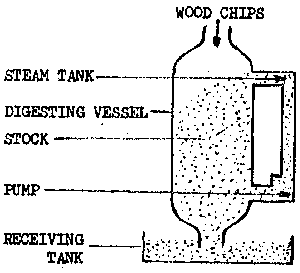
|
This is also referred to
as the Sodium Sulphide process and can be used for both hard and soft
woods particularly in the production of Kraft.
Chips are fed into a solution of Sodium Sulphide and caustic soda in a
large sealed vessel. The liquid is cycled through a steam heater and the
fibers in suspension pass into a receiving tank beneath. The pulp is then
washed and screened to remove the chemicals. Turpentine and methanol are
by-products of this process. |
Sulphide Process (Acid):
This chemical process uses Sodium Sulphite and is most
applicable for hardwoods. The treatment is conducted in vessels similar
to those previously described, and is harder on fibers than the Sulphate
process.
Sodium dioxide and Calcium Bisulphite are added to the
wood chips in a digester and heated to 140 deg. C, dissolving the lignum.
The fibers are then washed and screened.
b) Mechanical Pulping
|
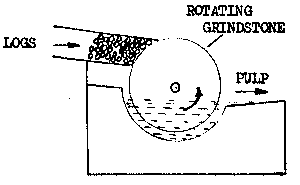 |
A physical method of fiber separation consisting
of grinding debarked logs under pressure against a grindstone in the presence
of water. Water serves to lubricate and cool the grinding surface of the
stone and to carry away the pulp. The logs are sometimes boiled or steamed
prior to grinding, thereby loosening the fibers and making the grinding
easier. The effect of this treatment is to darken the fibers.
Mechanical pulping is cheaper than the chemical process,
but is only used on softwoods. This is because fiber length is shortened
by mechanical breakdown and decreases in the length of hardwood fibers
could not be accepted. The fiber yield from wood is high (90 - 95%) but
the resulting fibers have little permanence when formed into board, as
they fade and turn yellow on exposure to light. Newspaper is made from
softwood mechanical pulp. |
Less severe mechanical treatment of fibers has been
achieved with the disc wood or refined ground wood pulping method. Wood
chips are fed into a disc refiner containing stationary and rotating abrasive
discs cooled by water.
c) Semi-Chemical Pulping
Chemical pulping whilst producing long fibers, has a
low yield (fibers to wood). The object of the semi-chemical process is
to produce as high a yield as possible commensurate with the best possible
fiber lengths. By this method which combines chemical and mechanical processes
up to 75% yield can be achieved, and the pulp is very strong, suitable
for wrapping papers, boards, newsprint.
The Neutral Sodium & Sulphite Process:
A pulp yield of 60 - 70% is obtained by cooking wood
chips in a 15% solution of Sodium Sulphate, in the presence of Sodium
Bicarbonate.
Further fiber separation can subsequently be obtained
by mechanical means using disc refiners. This process is particularly
suitable for hardwoods e.g. aspen, birch.
Acid Sulphite Process:
By modifying this normal chemical process, a pulp yield
of 65% can be obtained. The process consists of digesting wood chips with
hot sulphite liquor at high pressure, and then using disc refiners. The
pulp produced is used for newsprint and some mechanical printing grades.
After pulping, fibers are bleached and chlorinated.
Chlorination is a continuation of the digesting process and the object
is to remove the lignum remaining in the fibers without unduly attacking
the cellulose. Because Chlorination has little effect on the color of
the fibers, bleaching is also necessary when white fibers are required.
Comparison of Pulping Methods
| |
Chemical |
Mechanical |
Semi-Chemical |
| Cost |
Expensive process |
Cheapest |
Between Chemical and Mechanical |
| Yield |
40 - 60% |
90 - 95% |
60 - 75% |
| Fiber Treatment |
No Damage |
Reduces Length of Fibers |
Not severe reduction in Length |
| Fiber Strength |
Strong Fibers |
Weakened Fibers |
Strong Fibers |
| Color Properties |
Good |
Little Permanence |
Good |
Pulp Types, Characteristics and Uses:
Chemical Pulps:
- Softwood
Sulphate - Strongest pulps used for Kraft and bleached Kraft.
- Semi-Bleached
Softwood & Sulphate - Strong fibers, used for colored grades of carton
board and test facings.
- Bleached
Softwood Sulphite - Multi-purpose pulp used as a lining on carton board.
- Unbleached
Softwood Sulphite - Very strong pulp used as a liner for cream carton
board and underliner for white lined boards and as the backs of other
grades.
- Bleached
Hardwood Sulphate - Strong white expensive fibers used in solid white
board.
- Unbleached
Hardwood & Sulphate - Very rarely produced.
- Bleached
Hardwood Sulphite - A low strength pulp with high opacity used as a lining
with other bleached Softwood pulps.
- Unbleached
Hardwood Sulphite - Very rarely produced.
Mechanical Pulps:
- Mechanical
Softwood - Weak pulp but inexpensive and opaque. It is combined with other
pulps for chipboard, newspaper.
- Mechanical
Hardwood - Not produced.
Semi-Chemical Pulps:
- Hard
and Softwoods - Used for fluting, backs of -Duplex board, wrapping', newspaper,
etc.
Re-Used Fiber Sources:
- In addition
to virgin fibers, used paper and board are also repulped. The types of
paper and their uses are shown below:
- Mixed
Paper - Used for chipboard.
- Container
Waste - Produces strong pulp used for carton board and container liners.
- Colored
card - Used for the middles and backs of white lined carton boards.
- Newspaper
- Used for the middles and backs of white lined carton boards.
- Best
Quality Waste - Used as an under liner of carton boards.
3) Fiber Sources- Stock Preparation
|
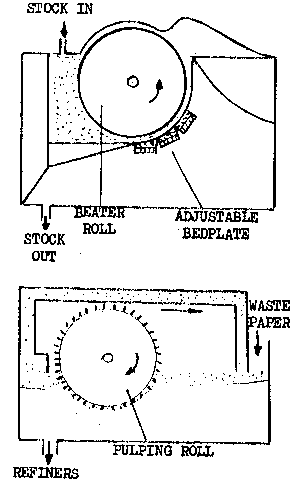 |
This is a two stage process
consisting of beating and refining. The object of beating fibers from
which to form a sheet of board is to develop the fiber condition described
as "hydration". Fibers absorb water and become frayed or fibrillated.
This condition, on drying is the source of the compacting bonding force,
which holds the fibers and by contraction, pulls the fibers more closely
together. This reduces the air space between the fibers and increases
the density of the finished sheet of paper.
Beating the virgin fiber for boardmaking is traditionally a batch process
but continuous methods are being introduced.
Pulp is fed into beaters (e.g. Hollander type shown) which consist of a
hard cylinder situated in a drum cavity. The gap between the roller and
the base plate is gradually reduced as the stock is circulated. The pulp
at this stage is 99% water. Beaten stock is fed to storage chests prior
to refining.
Reused materials (e.g. wastepaper for container middles) are disintegrated
into individual fibers by Shartle pulpers. Bales of waste are fed into
a continuous channel of hot water and pulp mixture. They pass into a disintegrating
chamber fitted with a large toothed roll where they are broken down. The
pulp is then pumped up to a higher level for recirculating. When the fibers
are sufficiently freed, the pulp is emptied into a tank or fed into refiners.
|
The effect of this mechanical beating on fibers is to:
a) Shorten the fiber length by transverse cutting.
b) Remove the outer wall of the fiber.
c) Absorb water causing the fiber to swell and rupture,
thereby releasing small "tentacle like" projections called fibrils.
(This is known as fibrillation).
d) Split longitudinally forming ribbons of fibrils.
e) Decrease the stiffness of fibers causing their collapse.
Fibrillation occurs over the whole surface of chemical
fibers which account for the very versatile fiber produced. On mechanical
fibers, however, fibrillation only takes place where the fibers are actually
split or broken owing to the percentage of lignum still present.
The greater the beating, and, therefore, formation of
fibrils, the greater the bonding of the paper web, and the smaller the
gaps between fibers. Chemical fibers for Kraft board would be beaten heavily
compared with mechanical fibers used for tissue where large gaps between
fibers in the mat give the paper its absorbency properties.
Refining is the second stage in stock preparation and
is a continuation of beating, whereby the fibers reach full hydration
without being reduced in length. Cone refiners such as Jordans are used
in series, the stock being cycled.
|
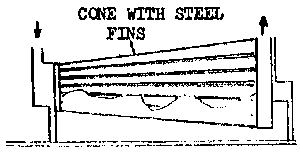 |
Cone refiners consist of
a central rotating cone with wooden longitudinal strips which fit closely
into an outer shell. Stock at this stage is approximately 99% water, and
is pumped with the direction of the central cone. |
The passage of stock in refiners is much faster and
smoother than in beaters. "Rosin" size is added to the pulp
at the refining stage; this is used to impart water resistance properties
in the finished board.
Stock of "finished stuff" as it is known at
this stage, is fed directly to the board machines for web forming or to
stuff chests for storage.
A continuous treatment of fibers, particularly from
reused sources, is with hydrapulpers. These are large steel vessels into
which waste paper etc. is conveyed. A series of rotating blades in the
base reduce the waste to fibers and contraries are channeled out on a
vertical bucket elevator connected to the base of the pulper, or attach
themselves to a dangling derager rope. From hydrapulpers the stock would
pass to Jordans for refining.
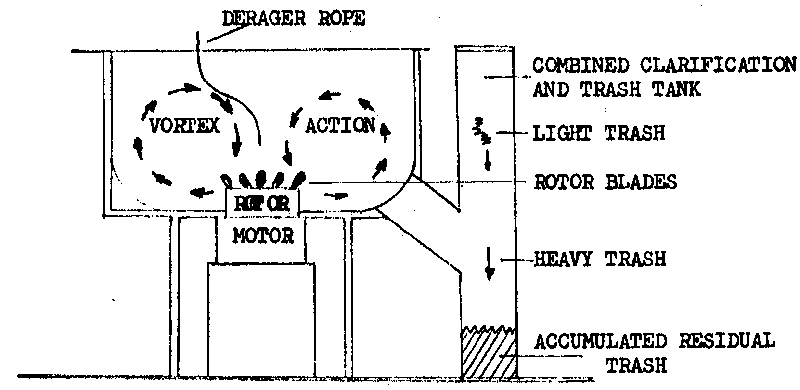
Web Forming
The action of web forming is common to all types of
board and involves the fibers in suspension being fed in one or more layers
onto the moving wire or felt of A board machine. They are shaken, some
of the water is removed, and the fibers are consolidated. Three types
of machine are used in the production of the board;
Fourdrinier
machine
Cylinder
machine
Inverform
machine
a) Fourdrinier Machine
This type of machine was first used early last century
and produces a homogeneous board, In essence, it consists of a box filled
with stock, feeding a continuous moving wire on which the fibers form
the board web.
Stock at 1/2% consistency is held in stuff chests prior
to feeding into the machine headbox. This regulates the amount and consistency
of the stuff which flows into the machine breastbox. Transversing the
machine, the breastbox feeds the fiber suspension onto the wire, ensuring
the even discharge of fibers at constant velocity with the minimum of
turbulence. Situated at the mouth of the breastbox is the "slice"
which is an adjustable metal blade or bar designed to maintain an even
flow of randomly oriented fibers. The fibers on the flat wirebed form
together, interbinding at the fibrils. Specific mesh sizes are required
for different boards. On either side of the wire are adjustable deckle
straps which ensure no fibers spread beyond the required deckle.
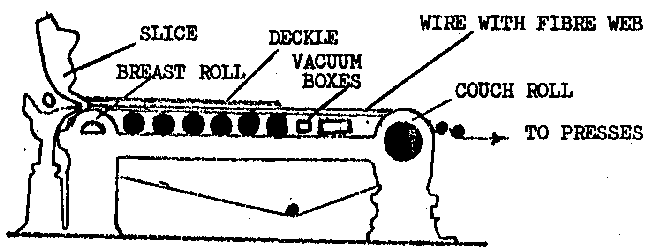
As the speed of the wire is greater than that of the
stock when fed on, the water which flows out carries with it the smaller
fibers, dies etc., leaving behind the longer fibers which are oriented
in the machine direction. To overcome this, the wire is shaken from side
to side as it moves forward to move some of the fibers into the cross
direction of the sheet as formation begins to take place.
Backwater, containing fibers, drains downwards from
the web, and is collected in trays pumped back to the stock preparation
department for reuse. At this stage, the web has about 10% fiber consistency.
More water is removed by atmospheric pressure as the wire passes over
a series of vacuum boxes. The amount of water removed depends on the resistance
of the fibers as the matt becomes progressively thicker, and the number
of vacuum boxes in use. The maximum calmer of board depends on the effectiveness
of water removal; this is approximately 305 microns.
Finally, the wire carries the web through a "suction
couch roll" which removes as much water from the paper as can be
drawn out by suction. The couch roll consists of an outer shell of bronze
or stainless steel with a large number of perforations, connected to a
suction box. Sufficient water is removed to make the fibrous mat self-supporting;
it has a consistency of 20% fiber at this stage. The matt is then transferred
to an endless "wet felt" of woven fabric, by which it is supported
through the press section. The board machine wire is spray cleaned as
it passes underneath for the next cycle.
2) The Cylinder Machine
Cylinder machines were introduced to make board much
thicker than is possible on the single wire mesh of the Fourdrinier machine.
It consists of a series of web forming cylinders (up to 8) which build
up a thick matt of fibers onto a continuous felt.
|
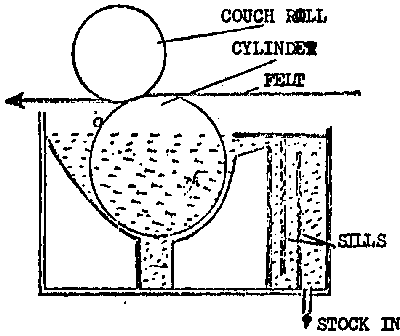
|
Stock at about 1% consistency
is fed into a series of vats in which a large mesh cylinder rotates. Two
adjustable sills inside the vat are used to control the flow of stock
and reduce turbulence. As the cylinder rotates it picks up randomly oriented
fibers and permits the water to drain through the wire, leaving the fibers
on the outside of the mesh. After it has been formed on the wire, the
fiber mat is picked off, by an endless band of felt which passes over
all the cylinder moulds of the machine and is pressed against each mould
by a separate couch roll covered with felt or rubber. The action of the
couch roll is to press as much water from the web as is possible, leaving
the mat in a condition to receive further layers of fiber from successive
cylinder moulds. |
The consistency of the fiber on the underside of the
felt at this stage is about 15%. Just below the felt, a shower sprays
the mould surface with water and so washes it ready for further immersion
in the stock. Most of the water draining through the wire, passes to the
circulating pump, which returns it to the stuff chests. Successive layers
of fiber are picked up from further cylinders as the felt moves. By using
different fiber stocks in the vats, a great variation in board types can
be made, for example, the board might have a sulphite lining, a Kraft
exterior, with the middle layers made from pulped waste papers.
|
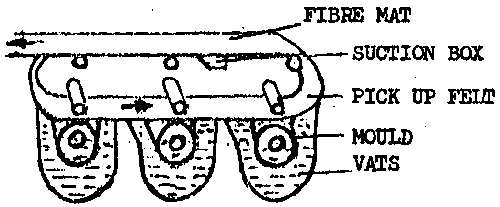 |
The lamination of the succeeding
sheets, one to another is effected by pressure and water alone, while
still in the formation or wet area of the machine. |
From the last couch, the felt passes round a suction
drum and into a pair of light press rolls. A top felt, which is used in
conjunction with the pick up felt, joins the top of the sheet and thus
sandwiches the sheet before it passes into the press section. Further
water is removed from the underside of the felt by vacuum boxes situated
under the felt. Before returning for fiber pick up, the felt is washed.
The fiber mat is transferred to a second felt which transports it through
the press section.
The Inverform Machine
This machine has been recently developed with the object
of providing a new method for the manufacture of single and multiple sheets
at higher speeds than could be obtained with the Fourdrinier or Cylinder
machines.
The fiber mat on a Fourdrinier machine is drained downwards,
and only one layer of fibers is formed as efficient drainage beyond this
cannot be achieved at high speeds. The Inverform machine overcomes this
problem by upward removal the water from the formed web. Each Inverform
unit (up to 5) can lay and remove water from the web of fibers, thus heavy
boards can be made with different fiber "layer" make-up.
Each Inverform unit has a flow box which is kept full
from stuff boxes. This regulates the flow of fibers onto the bottom wire.
A shaking action on the bottom wire ensures that all fibers will be randomly
oriented.
|
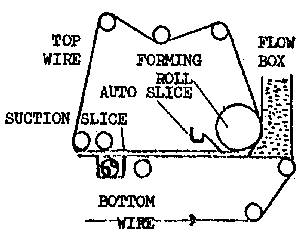 |
A top wire sandwiches the
fibers shortly after their formation and they pass into the "Autoslice".
This is a stiff, beveled scraper blade pressed lightly against the top
wire. Water is forced upwards through the top wire, swept up the sloping
blade and returned to the machine pit. With a single ply board, or the
bottom layer of a multiple, a quantity of water passes downwards, but
very little from other plies can drain downwards and, therefore, must
be removed upwards. Further water is removed after the autoslice by inverted
suction boxes, conventional boxes are used on the first layer. More water
is removed by a rotary vacuum box and the bottom wire then carries the
formed web to the next Inverform unit. The top wire passes overhead, is
washed and recycled. Up to 5 layers of fibers can be built up with the
Inverform system. The formed web is transferred to a felt before passing
into the drying section. |
The main advantages of the Inverform machine over the
Fourdrinier are the speed of formation and the greater weights of board
that can be achieved.
Drying and Finishing
Press Section
This normally consists of a series of light presses
gradually increasing in weight, whose function is to remove as much water
as possible from the sheet after it leaves the wire and before it enters
the drying cylinders. The fiber web is transferred from the board machine
wire or felt to a separate transporting felt. At this stage, the water
content is about 80% and the wet board is protected from the crushing
action of the rolls by a top felt. The water content is reduced to 60%
by the presses some of which may incorporate suction pressing.
Before leaving the press section, the board passes through
a series of finishing presses, carried on close weave felt to remove any
felt marks made by the main presses on the wet sheet. Finishing presses
are highly polished rolls of stone or metal. When the board leaves the
last of the main presses, it is dry and firm enough to be self supporting,
and the felts are cleaned and recycled.
Drying Section
The drying section consists of a series of hollow cylinders
heated by steam, the purpose of which is to drive moisture out of the
board by evaporation. The cylinders are 3 - 5 ft. in diameter, are accurately
bored inside and the outer surfaces are polished. Doctor blades are pressed
against those portions of the cylinders not in contact with the board,
to ensure the cylinders are kept clean and polished. Board is threaded
between the cylinders and water vapor blown from the spaces between the
cylinders by air jets. The board is dried down to about 4% moisture and
during this time, the fibers lose their water, shrink and bond, producing
an increase in strength of the web as it travels along the drying section.
Callendering
The water content of the board on leaving the drying
section is lower than the surrounding atmosphere. It is, therefore, raised
to normal by being passed over a "sweat roll" through which
cold water is circulated. Water vapor in the atmosphere condenses on the
roll and the moisture is taken up by the board. The board finally passes
through a callender stack which consists of a series of highly polished
rolls, designed to impart a smooth surface to the board, which is effected
by consolidation. These rolls are arranged in a vertical stack and are
friction driven by the bottom roller.
Following this surface treatment, the board is reeled
up, thus completing its manufacture.